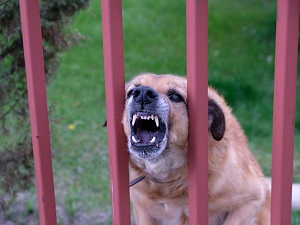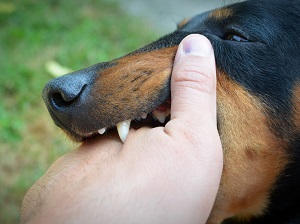For employees that work outdoors where people tend to walk their dogs and workers who regularly conduct business in residential neighborhoods, training and experience are key to occupational dog bite safety.

More than one-third of all US households have at least one dog. While most of these pets are friendly companions, workers should treat all dogs they encounter as potential threats, and act accordingly, for their own safety.
Dogs have instincts that may seem unpredictable when a stranger gets too close to their owner or perceived territory, and the nicest dogs may have the potential to become aggressive, sometimes without warning.
Many people may associate dog attacks with traditional or exotic breeds of guard dogs, but any breed of dog can bite someone and cause a serious injury.
Dog bites can be quite dangerous. Puncture wounds can easily become infected or turn into permanent scarring. If the bite is deep enough it can cause nerve damage that can lead to long-term loss of feeling or function. Tetanus and rabies are less common but can be transmitted through dog bites.
OSHA Standard 1926.21(b)(4) In job site areas where harmful plants or animals are present, employees who may be exposed shall be instructed regarding the potential hazards, and how to avoid injury, and the first aid procedures to be used in the event of injury.
Upon arrival at a customer’s property, if there has not been any prior notification that a dog is on site, it’s important to keep an eye out for anything that might suggest a dog is around. Look for things like a doghouse, animal tracks or waste, a warning sign on the gate, or bowls of food and water. If you see evidence that there might be a dog on the premises, ask the owner where the dog is being kept while work is being conducted.
Make a noise before you enter an area through a door or a gate. You can jingle keys, whistle, knock, or yell out a greeting to let animals know you are there and give you the opportunity to assess the number of dogs present.
If there is a dog on the property, insist the dog be restrained in a safe location before you enter the home or yard and remain restrained until you leave. The most effective way to prevent dog bites is to ensure the dog is secured in an area away from the workers.

If there is a dog on the property and the owner isn’t home, it’s important to know the company’s rescheduling policy in such instances. If rescheduling is not an option, do not run or make sudden movements. Try to gauge the dog’s temperament by looking at its body language.
If the dog is growling, looks tense, has its ears pulled back, or you otherwise believe the dog could harm you, leave the residence and contact your supervisor (or follow the company policy). Do not put yourself in danger. Avoid entering any area with an unrestrained dog.
If a dog calmly approaches, stand still and let it sniff you. Often the dog will leave you alone if they determine you are not a threat.
Dogs are more likely to bite or attack when they are:
- near their owner or other dogs, due to pack behavior.
- behind you.
- startled by a stranger.
- on a leash or in a run because they may feel cornered or threatened.
- outdoors, as opposed to indoors.
Understanding body language is key to avoid unexpected dog bites. Workers who routinely encounter dogs should know the clues that indicate when a dog is feeling anxious, afraid, threatened, or aggressive.
A dog that is feeling anxious or afraid will try to make themselves look smaller by crouching, lowering their head, or putting their tail between their legs. Dogs that are scared may try to slowly turn or move away but if they can’t retreat, they may defensively growl, snarl or even bite.
An aggressive dog will try to make themselves seem bigger. Fur on their back and tail may puff up, the tail may be straight up (or even be wagging), ears may be up and forward, and they may be showing their teeth, growling, lunging or barking. Do not approach a dog that is acting in a threatening manner.
Dogs that are feeling conflicted may demonstrate a variety of behaviors that can be confusing. A wagging tail or crouching posture does not mean a dog is friendly. Avoid any dog that is showing any signs of fear, aggression, or anxiety.

Workers can carry simple defense equipment with them that can be used in the event of a dog attack. If a dog charges, use anything on hand as a distraction, such as a hat, a stick, an umbrella, a clipboard, a jacket, a bag, a tool, or a dog baton.
Remember: Discouraging a dog from starting an assault is always better than fighting off an attack.
Specific tools that workers may carry, if authorized, include:
- Dog Bite Stick/Baton – By placing a stick or a baton between the worker and the dog, the animal is more likely to bite the object than the person.
- Dog Barriers/Stoppers or Umbrellas – These pop-action items can scare most dogs if used 6-8 feet away before they get too close. They also create a barrier between the worker and the dog providing an opportunity for them to back away from the property.
- Dog Deterrent Spray or Pepper Spray – While small and easy to carry, a spray may not be ideal on windy days and may not work on all dogs. Before using, make sure it’s legal to carry in your state.
- High Impact Whistle or Small Air Horn – Creating a loud sound can startle a dog enough to cause them to stop the attack, and it may also attract the attention of others (or the owner) who can assist, but it may not work with all dogs.

If you unexpectedly encounter a dog:
- Never run away from a dog or turn your back on a dog.
- If a dog starts to show aggression, then you should also act aggressive. Stand tall, act with confidence, assume a dominant posture and yell loudly. Use language like, “No!”, “Stop!”, “Go Home!”, etc.
- Put an object between you and the dog to allow yourself time to get to a safe place.
- Keep your back against a wall, the side of the house or a fence to prevent the dog from circling behind you and attacking.
Do not attempt to get near, touch, or pet a dog if the animal is:
- with their owner, but the owner has not given permission to touch the dog.
- not with their owner.
- on the other side of a fence.
- a service dog.
- sleeping, eating, or playing with a toy or chew item.
- sick, injured, or anxious.
- with their puppies.
- growling or barking.
- confined, tethered, or chained.
If a dog bite does occur, and the skin is broken, wash the area thoroughly. A visit to the doctor as soon as possible is recommended, especially if a copy of the dog’s vaccine record is not available.
Report all aggressive dog encounters so the company can update the account information on the property for future visits.


